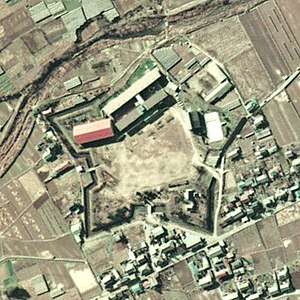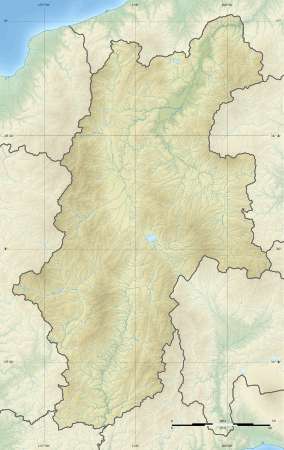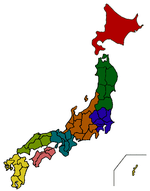Tatsuoka Castle
Tatsuoka Castle (龍岡城, Tatsuoka-jō) was a Bakumatsu period pentagonal "star fort" located in what is now part of the city of Saku, Nagano prefecture. It was the primary fortress of Tatsuoka Domain, ruled by the Ogyū-Matsudaira clan. Along with the Goryōkaku in Hakodate, Hokkaidō, it is one of only two star fortresses in Japan, and has been the site has been protected by the central government as a National Historic Site since 1934.[1]
| Tatsuoka Castle | |
|---|---|
龍岡城 | |
| Saku, Nagano, Japan | |
 Aerial photograph of Tatsuoka Castle site in 1975 | |
 Tatsuoka Castle  Tatsuoka Castle | |
| Coordinates | 36°11′46″N 138°30′06″E |
| Type | Star fort |
| Site information | |
| Condition | Ruins |
| Site history | |
| Built | 1867 |
| Built by | Matsudaira Norikata |
| In use | until 1868 |
| Garrison information | |
| Past commanders | Matsudaira Norikata |
Background
Tatsuoka Castle is located in a rural area of what is now the southern portion of Saku city, at the eastern edge of Nagano Prefecture, on a side route of the Nakasendō highway connecting Shinano Province with Kai Province and Kōzuke province.
History
The castle was built by Matsudaira Norikata (1829-1910) of the Ogyū-Matsudaira clan at the end of the Edo period. The Ogyū-Matsudaira were a cadet branch of the Matsudaira clan and formerly resided at Okutono Domain in Mikawa Province. Following the Perry Expedition and the arrival of the kurofune threatening Japan's national isolation policy, Matsudaira Norikata was appointed a Obangashira, or commander of Shogunate troops in 1863, only at 24 years old. A student of rangaku and western military science, he decided that the Okazaki area was vulnerable due to its proximity to the coast, and decided to relocate his seat to his holdings in the inland area of Saku.
As his holdings were small, he was unable to afford a very large fortification. The total size of the castle is approximately 200 meters per side, with a narrow moat with width of only five meters. At the five points of the star were gun emplacements, and gates were constructed on the northern and eastern sides. Due to its compact size and the location of the large daimyō residence in the center, the castle had little military value as it was impossible to defend in depth; furthermore, a nearby hill outside the castle meant that the interior could easily have been subjected to artillery fire. Nevertheless, this castle was regarded as revolutionary for Japan, and predates the more famous Goryōkaku by several years.
Following the Meiji restoration, Tatsuoka Castle was demolished and the site reverted to farmland. Later, an elementary school was built within the remnants of the moats. The castle was listed as one of the Continued Top 100 Japanese Castles in 2017.[2]
References
- "龍岡城跡". Cultural Heritage Online (in Japanese). Agency for Cultural Affairs. Retrieved 25 September 2018.
- "続日本100名城" (in Japanese). 日本城郭協会. Retrieved 25 July 2019.
- Motoo, Hinago (1986). Japanese Castles. Tokyo: Kodansha. p. 200 pages. ISBN 0-87011-766-1.
External links
| Wikimedia Commons has media related to Tatsuoka Castle. |
- Saku city home page(in Japanese)
- Jcastle Guide
